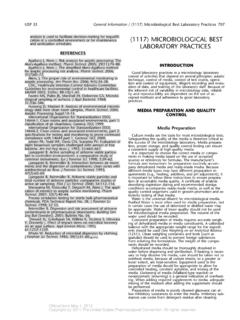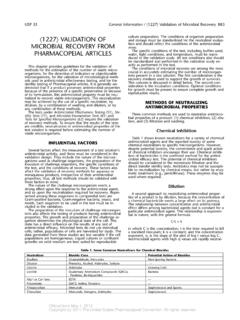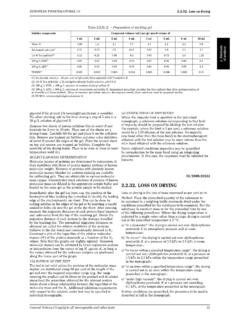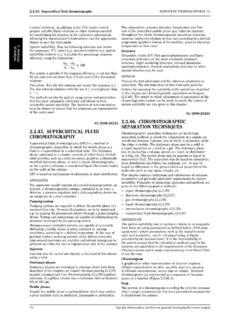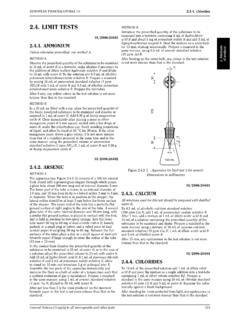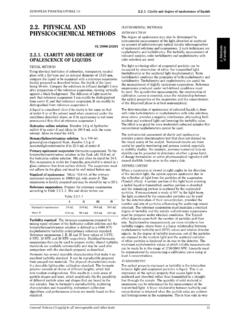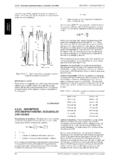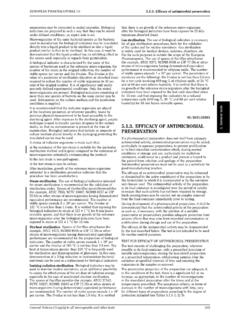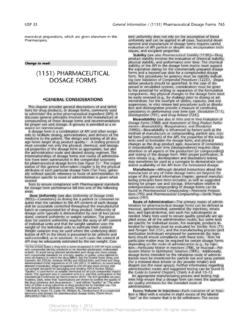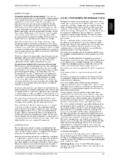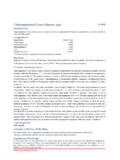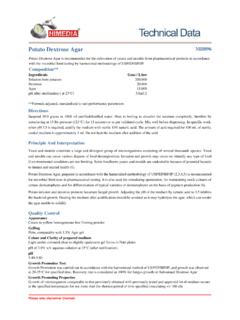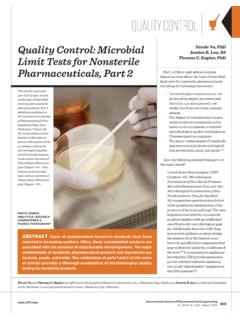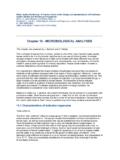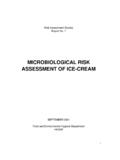Transcription of 2.6.12. MICROBIOLOGICAL - DrugFuture
1 EUROPEAN PHARMACOPOEIA Microbial enumeration teststhe animal from loss of body heat and maintain it so thatthe rectal temperature remains within physiological a cannula into the trachea. Insert a cannula filledwith a heparinised 9 g/L solution of sodium chloride into thecommon carotid artery and connect it to a device capable ofgiving a continuous record of the blood pressure. Insert into thefemoral vein another cannula, filled with a heparinised 9 g/Lsolution of sodium chloride, through which can be injected thesolutions of histamine and of the substance to be the sensitivity of the animal to histamine by injectingintravenously at regular intervals, doses ofhistamine solution Rcorresponding to gofhistaminebaseperkilogram of body mass. Repeat the lower dose at least 3 the second and subsequent injections not less than1 min after the blood pressure has returned to the level itwas at immediately before the previous injection.
2 The animalis used for the test only if a readily discernible decrease inblood pressure that is constant for the lower dose is obtainedand if the higher dose causes greater responses. Dissolve thesubstance to be examined in sufficient of a 9 g/L solutionof sodium chloride or other prescribed solvent, to give theprescribed concentration. Inject intravenously per kilogramof body mass mL ofhistamine solution R,followedby2 successive injections of the prescribed amount of the solutionto be examined and, finally, mL ofhistamine solution second, third and fourth injections are given not less than1 min after the blood pressure has returned to the level it was atimmediately before the preceding injection. Repeat this seriesof injections twice and conclude the test by giving mL ofhistamine solution Rper kilogram of body the response to mL ofhistamine solution Rper kilogramof body mass is not greater than that to mL the test isinvalid.
3 The substance to be examined fails the test if the meanof the series of responses to the substance is greater than themean of the responses to mL ofhistamine solution Rperkilogram of body mass or if any one dose of the substancecauses a greater depressor response than the concluding doseof the histamine solution. The test animal must not be used inanother test for depressor substances if the second criterionapplies or if the response to the high dose of histamine givenafter the administration of the substance to be examined isless than the mean response to the low doses of histaminepreviously MICROBIOLOGICALEXAMINATION OF NON-STERILEPRODUCTS:MICROBIALENUMERATION TESTS(1)1. INTRODUCTIONThe tests described hereafter will allow quantitative enumerationof mesophilic bacteria and fungi that may grow under tests are designed primarily to determine whethera substance or preparation complies with an establishedspecification for MICROBIOLOGICAL quality.
4 When used for suchpurposes follow the instructions given below, including thenumber of samples to be taken, and interpret the results asstated methods are not applicable to products containing viablemicro-organisms as active MICROBIOLOGICAL procedures, including automatedmethods, may be used, provided that their equivalence to thePharmacopoeia method has been GENERAL PROCEDURESC arry out the determination under conditions designed toavoid extrinsic microbial contamination of the product to beexamined. The precautions taken to avoid contamination mustbe such that they do not affect any micro-organisms that are tobe revealed in the the product to be examined has antimicrobial activity, this isinsofar as possible removed or neutralised. If inactivators areused for this purpose, their efficacy and their absence of toxicityfor micro-organisms must be surface-active substances are used for sample preparation ,their absence of toxicity for micro-organisms and theircompatibility with inactivators used must be ENUMERATION METHODSUse the membrane filtration method or the plate-count methods,as prescribed.
5 The most-probable-number (MPN) method isgenerally the least accurate method for microbial counts,however, for certain product groups with a very low bioburden,it may be the most appropriate the product and the required limit of micro-organisms. Thechosen method must allow testing of a sufficient sample size tojudge compliance with the specification. The suitability of themethod chosen must be GROWTH PROMOTION TEST, SUITABILITY OF THECOUNTING METHOD AND NEGATIVE CONSIDERATIONSThe ability of the test to detect micro-organisms in the presenceof product to be tested must be must be confirmed if a change in testing performance,or the product, which may affect the outcome of the test OF TEST STRAINSUse standardised stable suspensions of test strains or preparethem as stated below. Seed lot culture maintenance techniques(seed-lot systems) are used so that the viable micro-organismsused for inoculation are not more than 5 passages removedfrom the original master seed-lot.
6 Grow each of the bacterialand fungal test strains separately as described in Table buffered sodium chloride-peptone solution pH orphosphate buffer solution pH to make test suspensions; tosuspendA. brasiliensisspores, per cent of polysorbate 80may be added to the buffer. Use the suspensions within2 h or within 24 h if stored at 2-8 C. As an alternative topreparing and then diluting a fresh suspension of vegetativecells ofA. brasiliensisorB. subtilis,astablesporesuspensionis prepared and then an appropriate volume of the sporesuspension is used for test inoculation. The stable sporesuspension may be maintained at 2-8 C for a validated periodof CONTROLTo verify testing conditions, a negative control is performedusing the chosen diluent in place of the test preparation . Theremust be no growth of micro-organisms. A negative controlis also performed when testing the products as described insection 5.
7 A failed negative control requires an PROMOTION OF THE MEDIATest each batch of ready-prepared medium and each batch ofmedium, prepared either from dehydrated medium or from theingredients portions/plates of casein soya bean digest broth andcasein soya bean digest agar with a small number (not more than100 CFU) of the micro-organisms indicated in Table ,using a separate portion/plate of medium for each. Inoculateplates of Sabouraud-dextrose agar with a small number (not(1) This chapter has undergone pharmacopoeial harmonisation. See Pharmacopoeial Notices (1) apply to all monographs and other Microbial enumeration testsEUROPEAN PHARMACOPOEIA preparation and use of test micro-organismsGrowth promotionSuitability of counting method in thepresence of the productMicro-organismPreparation of teststrainTotal aerobic microbialcountTotal yeasts andmoulds countTotal aerobic microbialcountTotal yeasts andmoulds countStaphylococcus aureussuch as:ATCC 6538 NCIMB 9518 CIP 13276 Casein soya bean digestagar or casein soyabean digest broth30-35 C18-24 hCasein soya bean digestagar and casein soyabean digest broth 100 CFU30-35 C 3days-Casein soya bean digestagar/MPN casein soyabean digest broth 100 CFU30-35 C 3days-Pseudomonasaeruginosasuch as.)
8 ATCC 9027 NCIMB 8626 CIP 13275 Casein soya bean digestagar or casein soyabean digest broth30-35 C18-24 hCasein soya bean digestagar and casein soyabean digest broth 100 CFU30-35 C 3days-Casein soya bean digestagar/MPN casein soyabean digest broth 100 CFU30-35 C 3days-Bacillus subtilissuch as:ATCC 6633 NCIMB 8054 CIP 3134 Casein soya bean digestagar or casein soyabean digest broth30-35 C18-24 hCasein soya bean digestagar and casein soyabean digest broth 100 CFU30-35 C 3days-Casein soya bean digestagar/MPN casein soyabean digest broth 100 CFU30-35 C 3days-Candida albicanssuch as:ATCC 10231 NCPF 3179IP 1594 Sabouraud-dextroseagar or Sabouraud-dextrose broth 20-25 C2-3 daysCasein soya beandigest agar 100 CFU30-35 C 5daysSabouraud-dextroseagar 100 CFU20-25 C 5daysCasein soya beandigest agar 100 CFU30-35 C 5daysMPN: not applicableSabouraud-dextroseagar 100 CFU20-25 C 5daysAspergillus brasiliensissuch as:ATCC 16404 IMI 149007IP 9455 Sabouraud-dextroseagar or potato-dextroseagar20-25 C5-7 days, or until goodsporulation is achievedCasein soya beandigest agar 100 CFU30-35 C 5daysSabouraud-dextroseagar 100 CFU20-25 C 5daysCasein soya beandigest agar 100 CFU30-35 C 5daysMPN: not applicableSabouraud-dextroseagar 100 CFU20-25 C 5daysmore than 100 CFU) of the micro-organisms indicated in , using a separate the conditions described in Table solid media, growth obtained must not differ by a factorgreater than 2 from the calculated value for a standardisedinoculum.
9 For a freshly prepared inoculum, growth of themicro-organisms comparable to that previously obtained witha previously tested and approved batch of medium media are suitable if clearly visible growth of themicro-organisms comparable to that previously obtained with apreviously tested and approved batch of medium OF THE COUNTING METHOD IN THEPRESENCE OF of the depends upon the physical characteristics of theproduct to be tested. If none of the procedures described belowcan be demonstrated to be satisfactory, analternative proceduremust be products. Dissolve or dilute (usually a 1 in 10dilution is prepared) the product to be examined in bufferedsodium chloride-peptone solution pH , phosphate buffersolution pH or casein soya bean digest broth. If necessary,adjust to pH 6-8. Further dilutions, where necessary, areprepared with products insoluble in be examined (usually a 1 in 10 dilution is prepared) inbuffered sodium chloride-peptone solution pH , phosphatebuffersolution pH or casein soya bean digest broth.
10 Asurface-active agent such as 1 g/L of polysorbate 80 may beadded to assist the suspension of poorly wettable substances. Ifnecessary, adjust to pH 6-8. Further dilutions, where necessary,are prepared with the same products. Dissolve in isopropyl myristate, sterilised byfiltration or mix the product to be examined with the minimumnecessaryquantityofsterilepolysor bate80oranothernon-inhibitory sterile surface-active agent, heated if necessary tonot more than 40 C, or in exceptional cases to not more than45 C. Mix carefully and if necessary maintain the temperaturein a water-bath. Add sufficient of the pre-warmed chosendiluent to make a 1 in 10 dilution of the original product. Mixcarefully whilst maintaining the temperature for the shortesttime necessary for the formation of an emulsion. Further serialtenfold dilutions may be prepared using the chosen diluentcontaining a suitable concentration of sterile polysorbate 80 oranother non-inhibitory sterile surface-active or solids in aerosol form.
